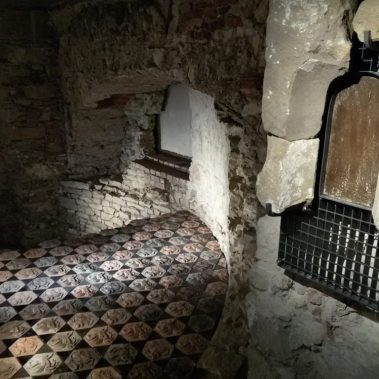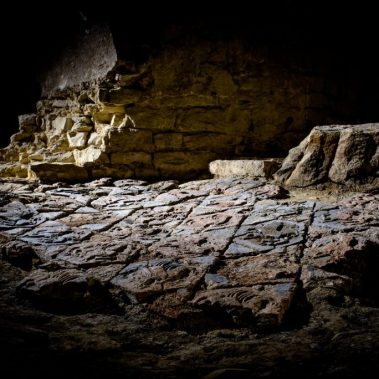
Address:
Malostranské nám. 2/25, 118 00, Prague, Czech Republic
Client:
Faculty of Mathematics and Physics of Charles University, Prague

Description of the work:
Restoration and construction works
Realization:
2016
The discovery of a well-left fragment of Romanesque ceramic paving of the Vysehrad-type floor tiles in its original position makes the rotunda a worldwide unique find. Tiles are of the triple shape type. Smaller ones have a triangular shape with brownish-purple to black glaze. Squares form a bordure frame along a straight stone step into an apse. The most numerous are hexagonal tiles, without glaze, decorated with motifs of a lion and a griffin (a mythical creature with an eagle’s head, wings and a lion’s torso).
Hexagonal tiles have become a symbol of the internet donation website www.nase-rotunda.cz, through which the Charles University IFF collected part of the funds for reconstruction. In addition to donations to the public. The project was largely funded by grants from Iceland, Liechtenstein and Norway.
The works within the St. Wenceslas Rotunda preservation project were of a construction and restoration nature. The works were closely supervised by the National Heritage Institute, archaeologists, an architect and other specialists.
The construction part of the project included disassembly of makeshift constructions within the rotunda space, mounting of an entry staircase leading from the Faculty’s corridor, manufacture and mounting of visitors’ walkways, brickworks, installation of replicas of the Romanesque tiles, installation of mains, air conditioning, lighting and audiovisual technologies.
Restoration work included the restoration of Romanesque masonry, the adjustment of other walls, the restoration of Romanesque tiles, the preservation of archaeological situations, the production and installation of replicas of historical paving, the installation of exhibits and illuminated graphics, the creation of a relief profile of the archaeological situation, paintings, color retouching and processing of restoration documentation.
The implementation of the project also had educational objectives. In accordance with the specifications, students of the Universities in the field of restoration were involved in professional work, in the form of professional school practice in the restoration. Excurses were organized for other students and the professional public.
GEMA ART had a possibility to acquaint colleagues from the Jordan heritage authorities with the course of work.
The project was granted two awards by the National Heritage Institute (Patrimonium pro futuro) and the European Heritage Award 2018 – EUROPA NOSTRA
The project was honored with the National Heritage Institute Award for 2016 year and in 2018 by the EUROPA NOSTRA.
Visit the Rotunda right now from the comfort of your home thank to a virtual guide.

























